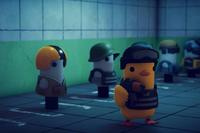Ben Milligan's new book, "By Water Beneath the Walls: The Rise of the Navy SEALs," is not your typical Navy SEAL book. There is not a single mention of how the author successfully completed the toughest military training in the world, the BUD/S (Basic Underwater Demolition/SEAL) training.
This is first a well-researched study of history that goes back to the years just after World War I when the political and economic situation of the times required conventional leaders to think out of the box and create soldiers, sailors and Marines who were "raiders, commandos and amphibious operators."
Second, it is an entertaining storyline detailing incredible "special operations" missions conducted by brave and larger-than-life Americans throughout World War II, Korea and Vietnam from all of the services, not just the Navy. These missions and lessons from the Army Scouts, Army Rangers, Special Forces, Marine Raiders and RECON, and the Navy's own Navy Combat Demolition Units (NCDU) and Underwater Demolition Team (UDT) were the historic backbone of today's Navy SEAL teams.
The building of today's CIA from the World War II Office of Strategic Services by pioneers such as William Donovan also played a significant role in creating a maritime special operations unit that would inevitably be run by the Navy, thanks to such brilliant thinkers and leaders as the Chief of Naval Operations Arleigh Burke.
"By Water Beneath the Walls" is more of a joint special operations history book than an individual Navy SEAL book. Great military and even political minds were key to taking advantage of the geopolitical and military situation to forcefully influence the need for such unconventional war fighters. The internal military and political battles fought by many of the founding fathers of today's special operations were won and lost throughout the decades between World War II and the Vietnam War, with many early special operations units being disbanded.
What has emerged today as a joint group of specialized military personnel within today's Special Operations Command (SOCOM) is the result of unconventional leaders sending brave men on harrowing missions behind enemy lines. The missions' successes and failures and larger-than-life egos were often a double-edged sword for the fledgling organizations that soon became the most decorated units within the military. The need for small unit tactics was proven over and over until the military found the formula for peacetime training (versus disbandment) and wartime operational tempo.

I found it funny that "Navy SEAL book" does not mention the term "Navy SEAL" until chapter 11 when a creative naval officer used the term SE-A-L as an acronym for units that were capable of fighting from the water, air and on land well behind the amphibious range of the hinterland (lands closest to the coasts of waterways). However, there are plenty of Scouts and Raiders and NCDU and UDT missions expertly described etching these brave men into history of the formation of the unit that today is the Navy SEAL team.
Milligan just so happens to be a combat veteran and former Navy SEAL, but he is first and foremost an engaging historian. His writing style is comparable to many of the history books of David McCullough, such as "1776," "Mornings on Horseback" and "The Pioneers." I found the best part of this book to be the bibliography that makes up nearly 20% of the book's bulk, giving an endless supply of resources on many of the individual forefathers if you want to read with greater detail in the future.
Milligan's genius in writing is immediately observed on the first page of the book when the odd title, "By Water Beneath the Walls," is explained by a covert mission where ancient frogmen swam through an aqueduct beneath the walls of the fortress. I was hooked immediately.

















